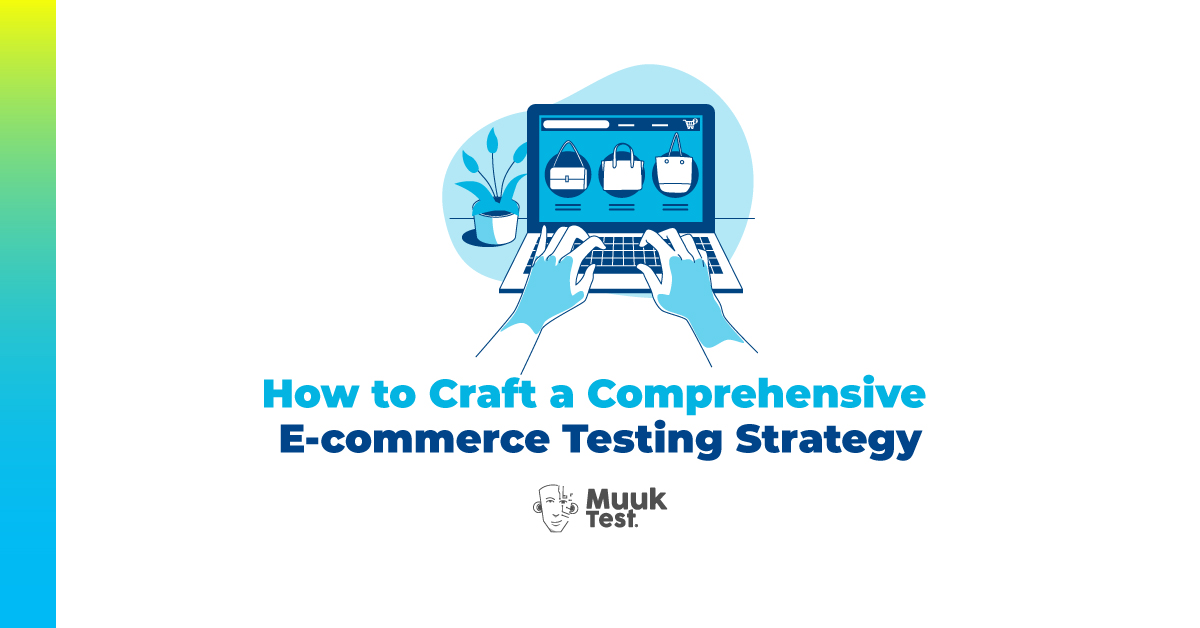Step into the exciting world of any e-commerce platform, where one click reveals a universe of products and possibilities. But did you know that there’s always a careful e-commerce testing plan in place to make sure everything works smoothly?
In this article, we’re going to attempt to design a crisp testing strategy for a popular e-commerce giant, i.e., Amazon. We will try to cover the key aspects of a good testing strategy in the context of Amazon so that you can easily relate and understand it better. An e-commerce testing strategy is like a special recipe for making sure everything on their platform works just right.
We’ll delve deep into this testing strategy using a popular test strategy model, i.e., Heuristic Test Strategy Model (HTSM). We will cover important aspects from HTSM such as Project Environment, Product Elements, and Quality Criteria Evaluation to create this ultimate recipe for testing success!
Understanding the E-commerce Testing Landscape
To write any test strategy, we first have to explore the foundational project aspects of the product under test. Here, we will try to uncover all these aspects of Amazon using the guidewords from HTSM.
Mission
This refers to the purpose of this project. Amazon’s mission revolves around delivering a diverse range of products efficiently to customers worldwide. The mission can often change with time and thus require the testing team to keep re-evaluating it to align themselves with the business mission. For example, during the COVID-19 pandemic, Amazon’s mission prioritized essential items for customers.
Information
This refers to the information needed for e-commerce testing, which includes product information such as the vast product listings, user profiles, transaction history, etc. This also includes the engineering documents, help section, FAQs, support team manuals, etc.
Developer Relations
Refers to collaboration channels between development and testing teams. Close collaboration allows the testing team to understand new features and updates, ensuring effective communication. For example, the frontend team can be contacted by the backend team daily for clarifications and doubts.
Test Team
This refers to the people involved in the testing work, including those involved in unit testing, functional testing, security testing, performance testing, usability testing, accessibility testing, etc. For example, testers from different regions assess localized features and content for accuracy.
Equipment & Tools
It refers to test setups, documents, automation frameworks, load testing tools, device testing platforms, etc. Automated checking tools will help Amazon efficiently test different aspects of the website, such as UI responsiveness and backend processes. For example: Real-device testing ensures that Amazon’s mobile app functions flawlessly on diverse smartphone models.
Schedule
This refers to the sequence and synchronization of project events. Amazon’s frequent updates and releases require continuous testing jobs to run over CI pipelines. This may also include checks on merge requests, pull requests, etc. For example: Prime Day offers need extensive testing before the event to manage anticipated high traffic volumes.
Test Items
This includes various aspects of the product to be tested. Thorough testing of recommendation algorithms ensures that customers receive accurate product suggestions. Testing payment gateways guarantees secure transactions. This could be a critical aspect of Amazon’s e-commerce operations. Similarly, we will identify the scope, testability, and volatility of various test items here.
Deliverables
This refers to the deliverables from the testing team. For example, bug reports, change requests, test cycles, test reports, CI pipelines, etc. This can also include information about standards followed in terms of test documentation, strategy, planning, etc.
Product Elements: Unveiling the Layers
In this section, we’ll dissect Amazon’s platform, highlighting the dimensions that need to undergo rigorous testing and areas to focus on from the testing coverage standpoint.
Structure
This refers to everything that comprises the product.
- Code: The intricate lines of programming that bring Amazon.com to life, from the search bar to the checkout process.
- Service: This includes a fast delivery service and its sync with the platform.
- Collateral: The extra things that make Amazon.com special, like the terms and conditions you agree to, data protection guidelines, etc.
Function
This refers to everything that the product does. Below are a few examples:
- Testing the placement of key elements like search bars and filters ensures intuitive navigation for users.
- Validating features like search filters, cart management, and payment processing.
- Cart management features need to undergo rigorous testing to prevent accidental deletions.
Data
This refers to everything that the product processes. Here are some examples of different kinds of data coverage possible:
- Input/Output: The data that you type into Amazon’s search bar and the product listings that appear as a result.
- Preset: The default settings that Amazon uses, like the currency and language preferences set based on your location.
- Persistent: The choices you make when you customize your Amazon account, such as saved payment methods and your delivery address.
- Cardinality: The number of items in your shopping cart, which can vary from none to many as you shop.
- Invalid/Noise: Any gibberish or incorrect data that might accidentally be entered into a search field or a review.
Interfaces
This includes interactions between different parts of the platform. Some examples include:
- Testing the integration between the website and the mobile app to ensure a consistent user experience across devices.
- Testing the integration with third-party payment gateways to ensure a smooth payment process.
Platform
Checking compatibility with various devices and browsers.
- For example, testing the platform on different browsers and devices will ensure that customers can access Amazon regardless of their preferred platform.
- Similarly, Cross-device testing ensures a consistent experience whether customers shop on a laptop, tablet, or smartphone.
Operations
This includes all the aspects of how the product will be operated. For example:
- User Personas: The different types of users who use Amazon.com, like customers, sellers, reviewers, etc.
- Common Use: Common use cases such as searching for items, reading reviews, adding products to cart, etc.
- Extreme Use: Putting Amazon to the test by performing complex searches, comparing prices across multiple categories, and exploring various product details.
Time
This includes the relationship of the product with time.
- Input/Output: Time between typing something in the search bar and the search results to appear.
- Fast/Slow: Testing how Amazon reacts to quickly clicking on different products versus taking your time to decide.
- Concurrency: Simulating multiple users searching for products simultaneously and seeing how Amazon’s system manages this shared activity.
Quality Criteria: Elevating the User Experience
The next thing to ponder now are the key quality criteria for Amazon’s which will define what the product should be like. Let’s try to evaluate the various quality criteria for an e-commerce platform like Amazon:
Capability
This will cover all the aspects to ensure that the product performs the intended functions.
- Sufficiency: Ensuring that Amazon’s platform has all the tools and features needed to provide a complete and satisfactory shopping experience.
- Correctness: Confirming that Amazon’s system is designed and programmed accurately, so when you make a purchase, the correct items are added to your cart and the right amount is charged.
Reliability
This will check if the product works well and resist failures in required situations.
- Robustness: Checking that Amazon’s website remains functional and efficient even as time goes on and more people use it exponentially.
- Error handling: Making sure Amazon’s system doesn’t crash or act unpredictably if it encounters incorrect or faulty information, and that it recovers smoothly from any hiccups.
- Safety: Making sure that using Amazon doesn’t lead to any data safety issues.
Installability
This includes checking if the app can be installed, uninstalled, and updated smoothly. For example, regular updates to the Amazon app need to be tested to ensure they install smoothly and without disrupting user experience.
Security
This includes safeguarding sensitive customer data from breaches and fraud. For example, rigorous security testing to prevent unauthorized access to customer payment and personal information.
Performance
This includes optimizing response times and loading speeds. For example, testing page load times ensures that customers can quickly access product information and make purchases. Performance testing would be required to evaluate server response times during high-traffic events to ensure smooth user experiences.
Usability
This ensures that the product is easy to use for its users. This covers aspects such as learnability, simplicity, operability, accessibility, error-proofing, etc.
Charisma
This targets the aesthetic appeal of the product. This covers aspects such as aesthetics, uniqueness, entrancement, image, etc. For example, consistent design elements and branding contribute to Amazon’s recognizable and attractive interface.
Scalability
This includes verifying the platform’s ability to grow and meet increased demand. For example, scalability testing to ensure that Amazon’s infrastructure can handle sudden spikes in traffic during major sales events.
In Summary
In conclusion, a robust testing strategy for the e-commerce industry involves a holistic approach that considers its project environment, product elements, and quality criteria evaluation. By aligning these elements, testing teams ensure a seamless, secure, and user-friendly experience. Just as e-commerce platforms operate flawlessly, the testing strategy stands as the unsung hero in the dynamic realm of e-commerce.




%20(1).png?width=150&height=69&name=MuukTest-logo---light-background%20(3)%20(1).png)
